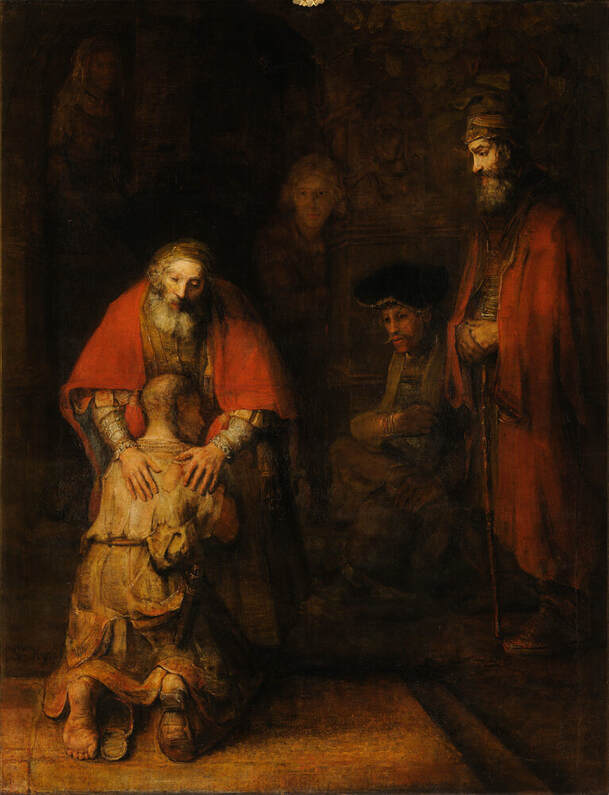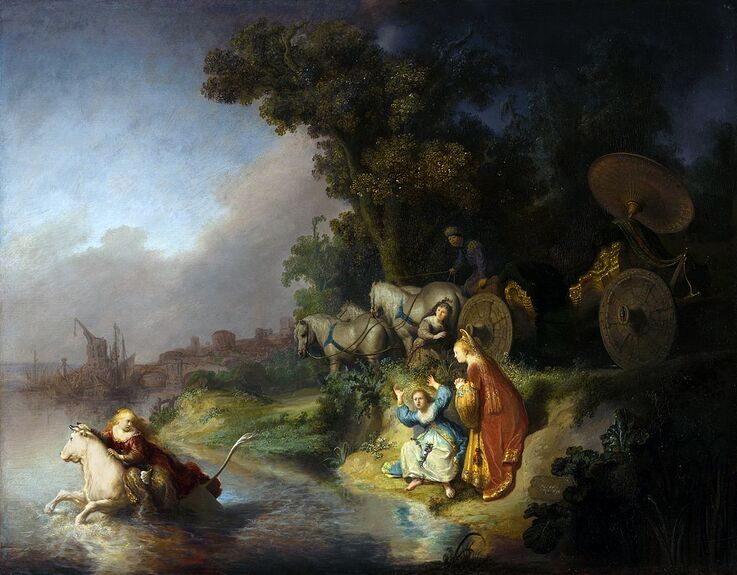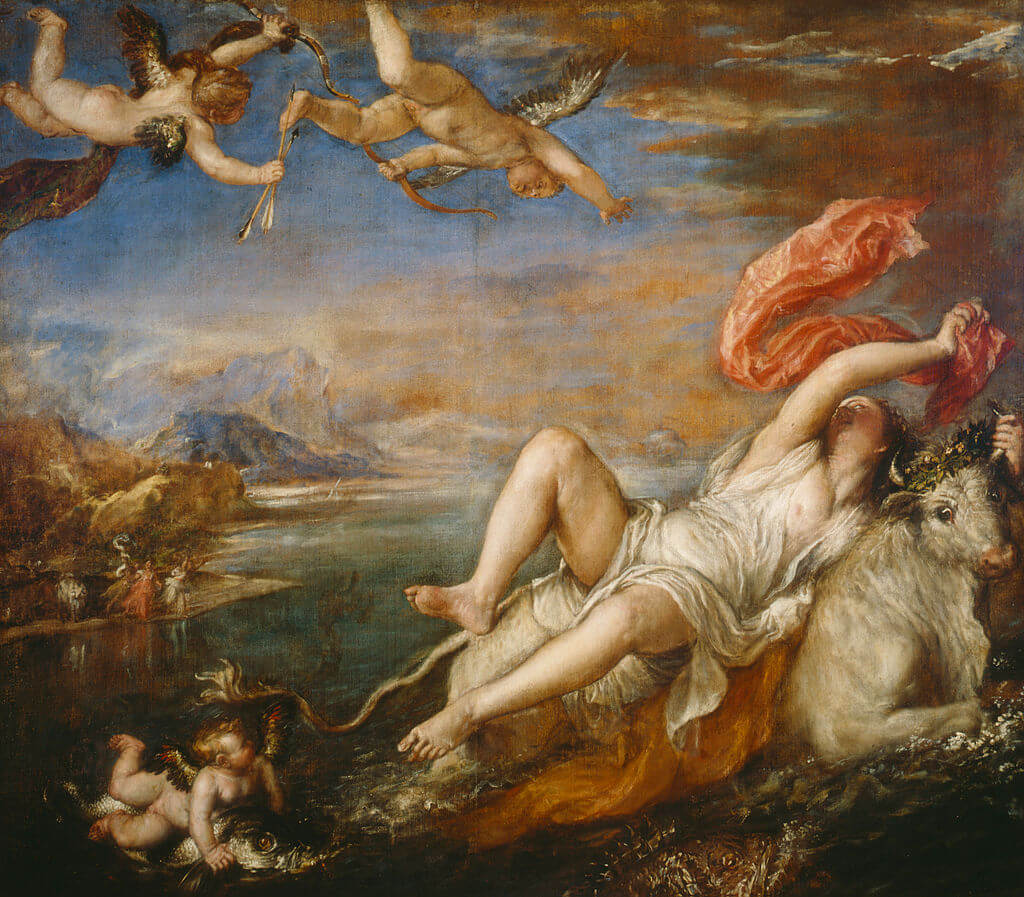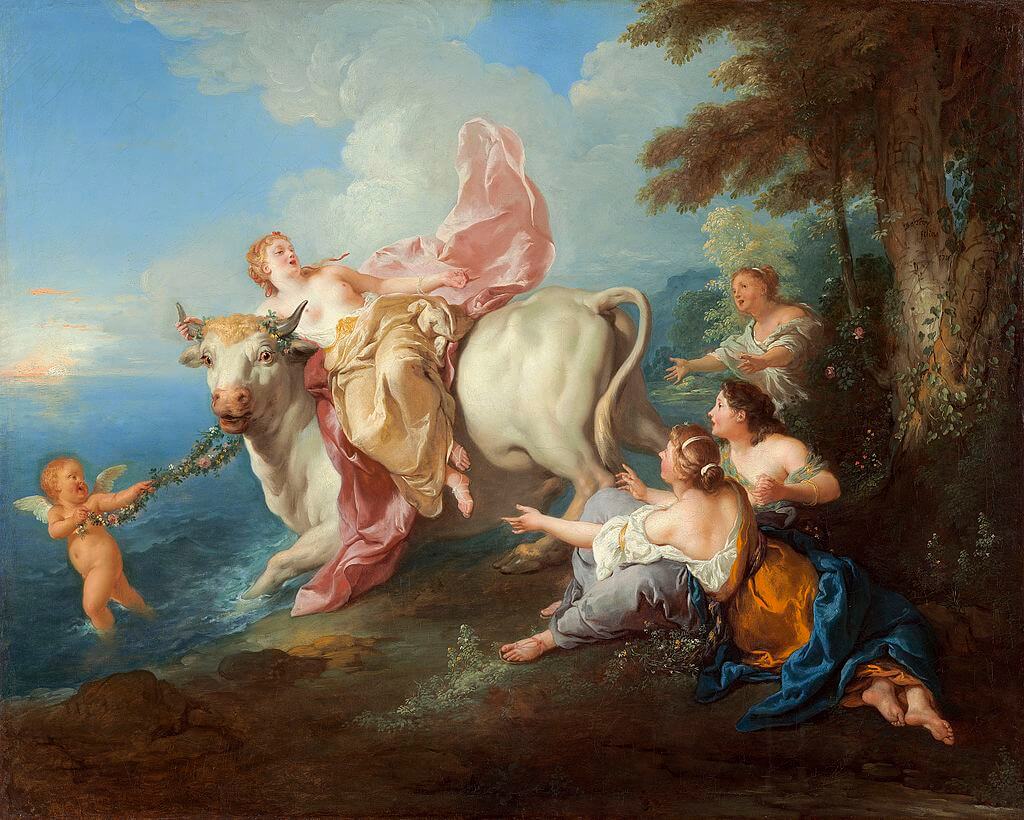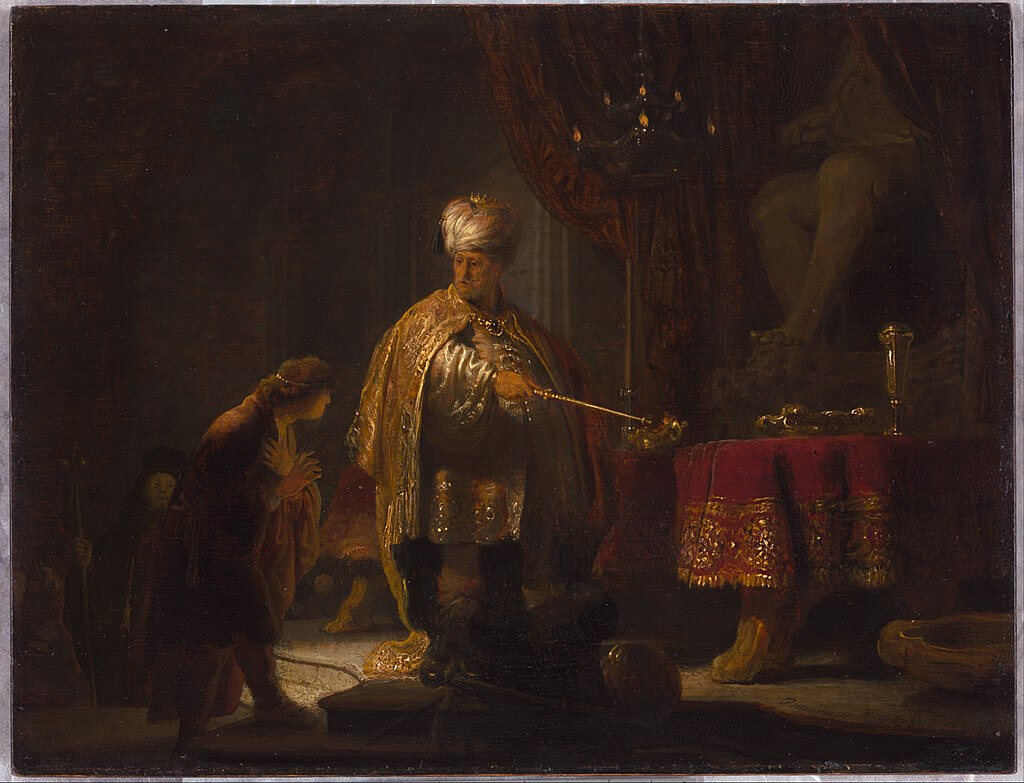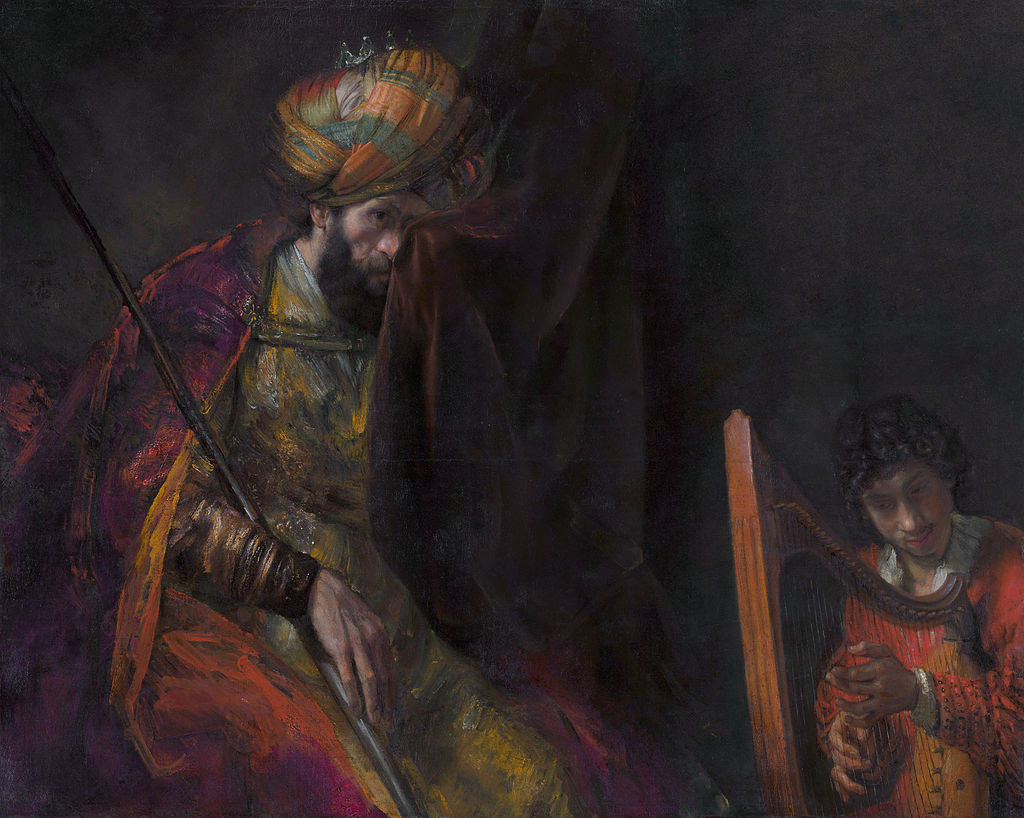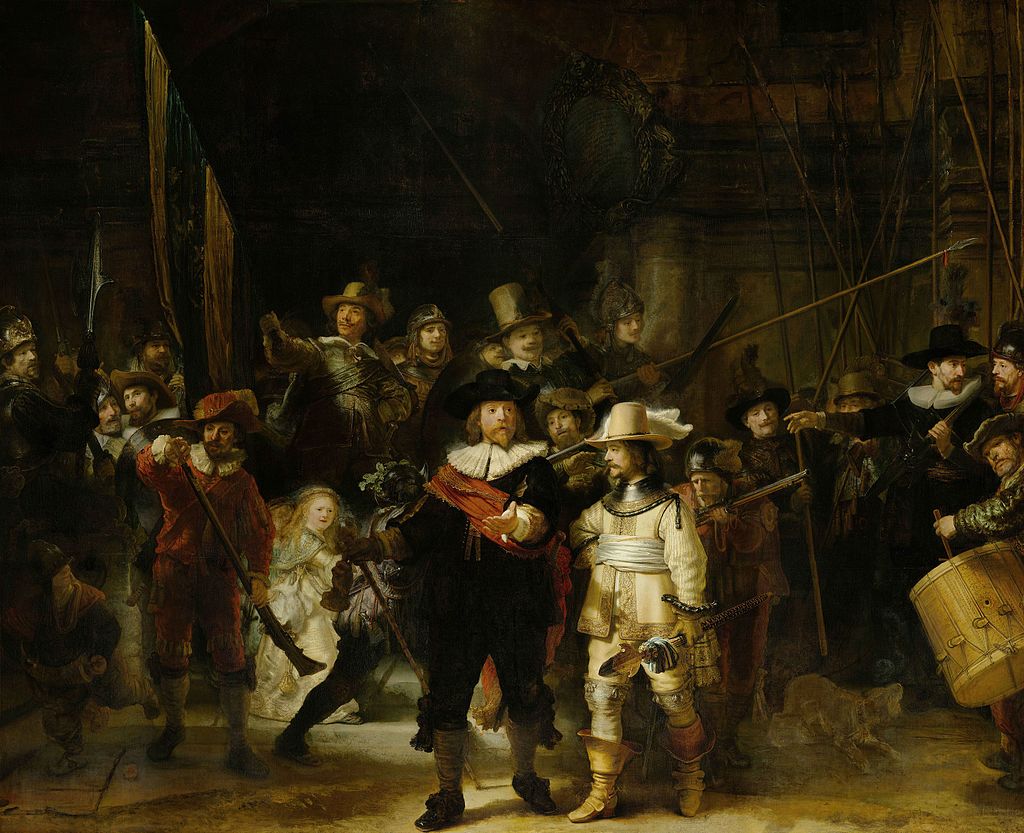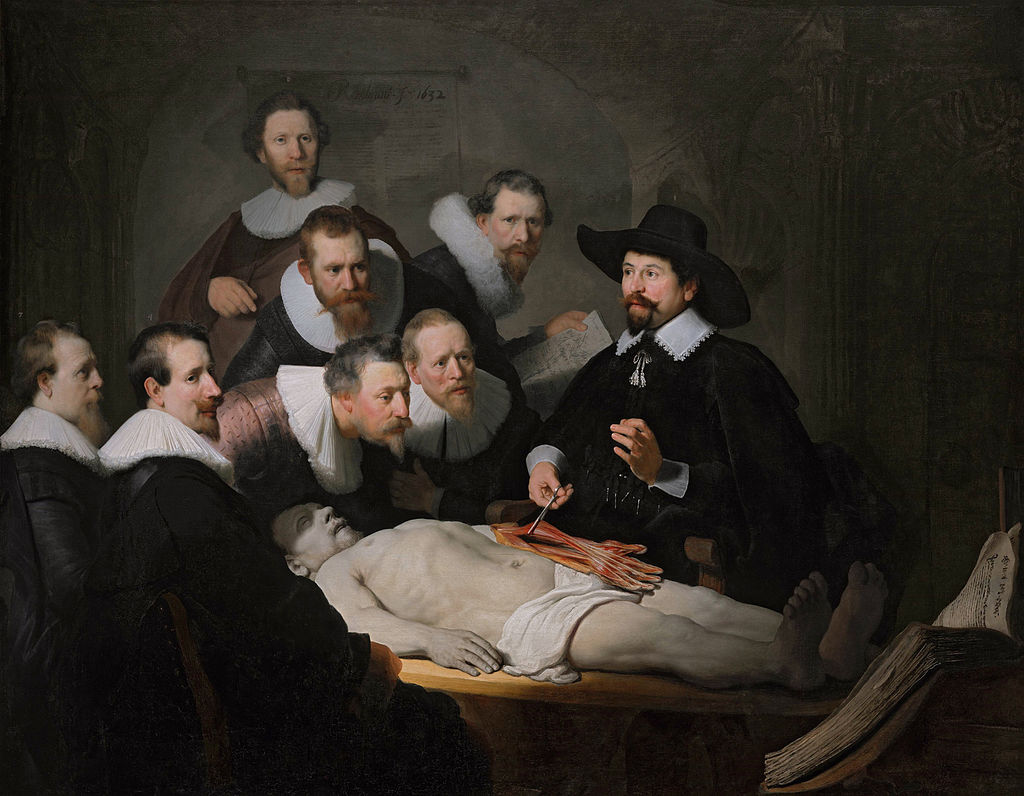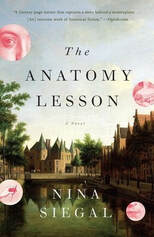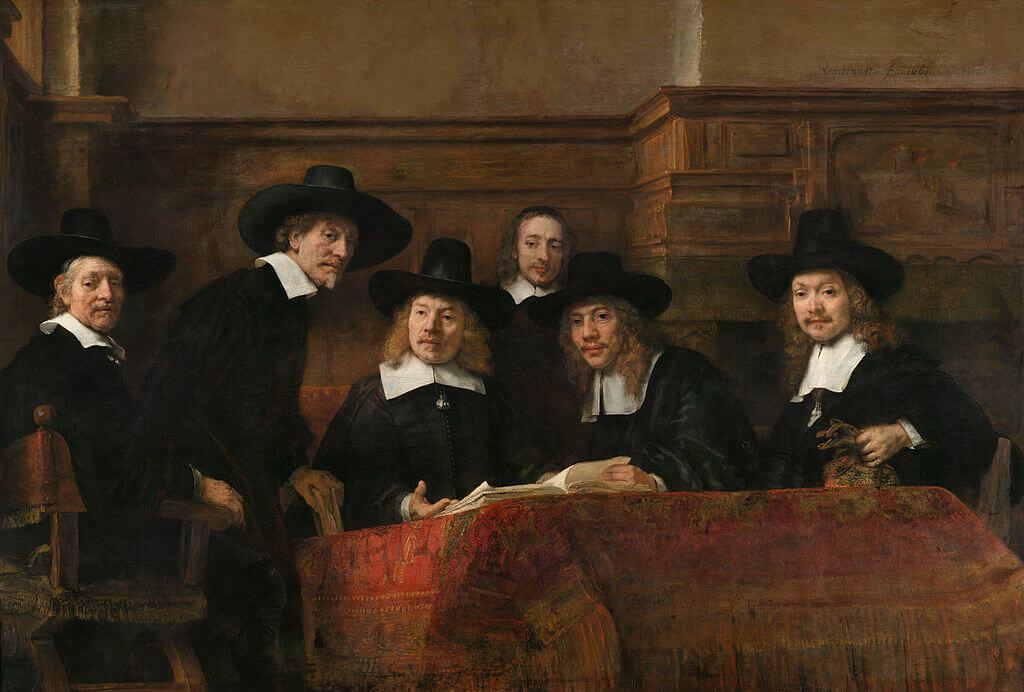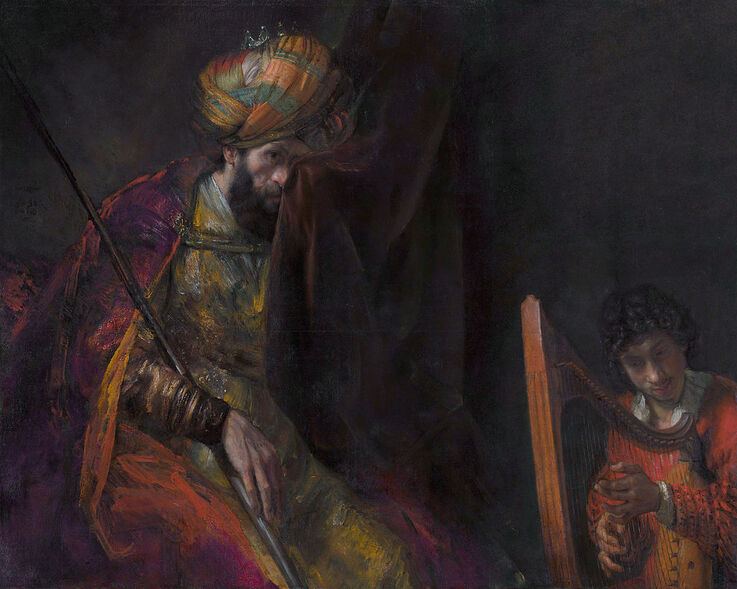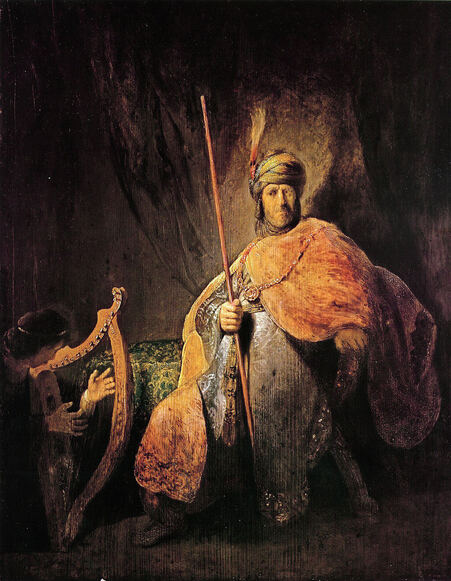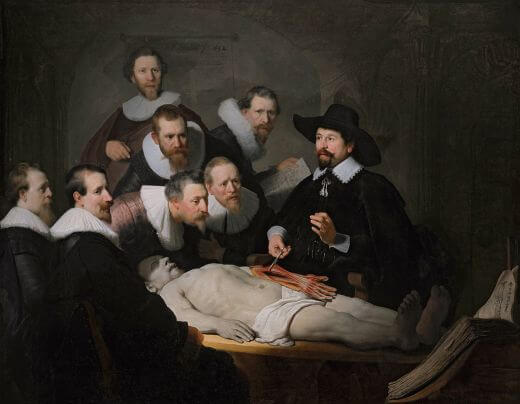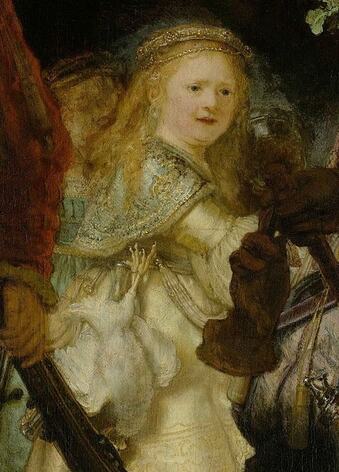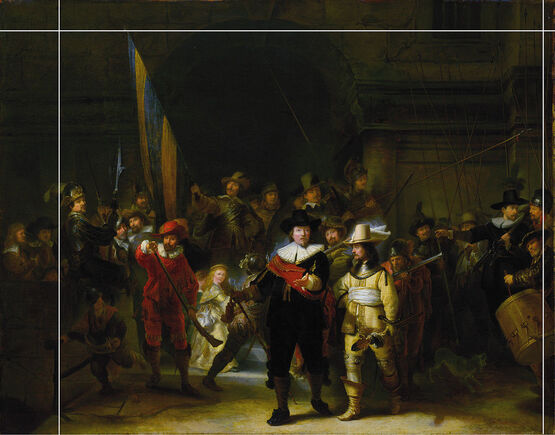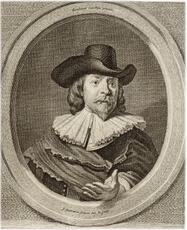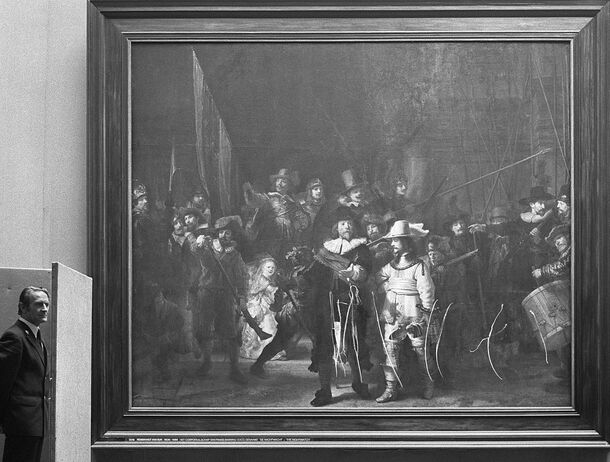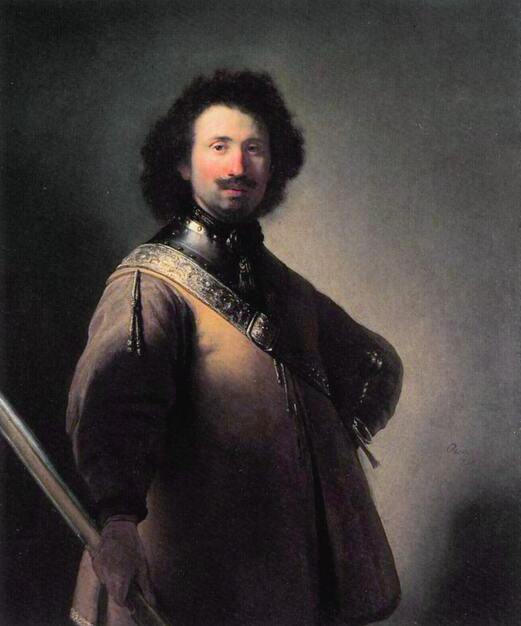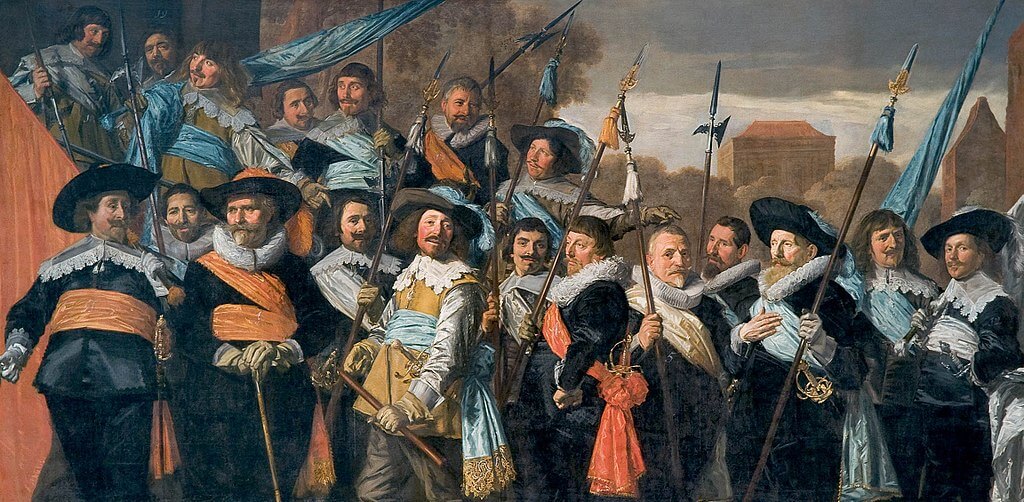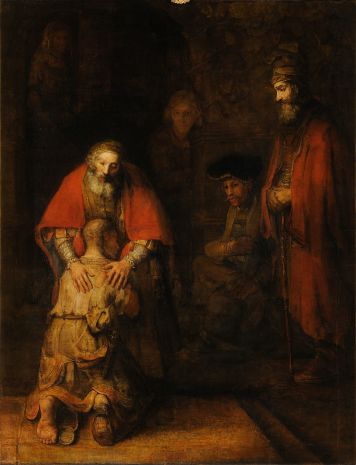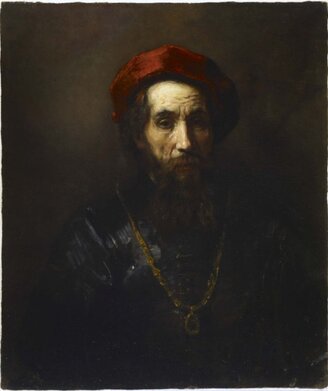|
Where? Room 254 of the New Hermitage building in the Hermitage Museum
When? 1668-1669 What do you see? Six(!) people in front of an arched doorway. On the left, an old man lovingly embraces a young and bold man who bows his head in humility. This is his son who returned home after a long time. While the father is dressed in beautiful clothes, the son is not. He wears old clothes with holes in it, and his sandals are worn and broken. He still wears the dagger on his belt that he needed to defend himself in the outside world. On the right, at a little distance, is the older son of the old man. Dressed in a red cloak, he has his hands folded while holding a cane. He looks at his younger brother with a mix of disapproval and envy. It is not certain who the other three people in this painting are. The woman in the middle background may be a sister or the mother of the prodigal son. The seated man with a mustache may be an older servant. On the top left, barely visible, is the silhouette of a female servant. Rembrandt uses light to emphasize the important aspects of the painting. The father and son are fully in the light, the older son is partially in the light, and the other people are in the darkness.
10 Comments
Where? Room E204 of the J. Paul Getty Museum
When? 1632 What do you see? The Ancient Roman god Jupiter (Zeus in Greek mythology) is disguised as a beautiful white bull. He just seduced Europa and takes her away on his back into the sea. He has his tail up as an indication that he is happy with the successful abduction. Europa sits on top of the bull, holding a horn with her right hand, and fearfully looks back at her servants on the shore. They are the Virgins of Tyre (where Europa lived as well), with whom Europa was playing before she got abducted. They watch in disbelief how Europa gets abducted. The woman in blue has dropped the flower garland they made for the bull in her lap and raises her hands up in the air. The other woman looks at Europa while folding her hands as if she resigns in Europa’s fate. In the background is the horse carriage with four horses that had brought Europa to the beach. The story of Jupiter and Europa? This story is based on the second book of Metamorphoses by the Roman poet Ovid (Amazon link to Metamorphoses). At the end of the second book, in lines 833 till 875, Ovid describes how Jupiter falls in love with Europa. She was the daughter of a king in an Eastern land. Jupiter asks his son Mercury to go to that land and drive the herd of royal kettle to the beach, where Europa is playing with her servants. Jupiter disguises himself as a tame white bull and puts himself among the royal kettle. Europa recognizes his beauty and starts to play with him. While a bit afraid at first, she eventually climbs on his back, and Jupiter takes that opportunity to walk into the water and escape with her on his back. This story has also inspired other painters. Titian painted The Rape of Europa in the Isabella Stewart Gardner Museum in Boston, and Jean-François de Troy painted The Abduction of Europa in the National Gallery of Art in Washington, DC.
Background: This painting is one of only few paintings by Rembrandt in which he included an extensive landscape. The Getty Museum acquired it in 1995 for about $27 million, which was a new record for a Rembrandt painting at that time. They bought it together with another painting by Rembrandt, Daniel and Cyrus before the Idol Bel, which is also still in the Getty Museum.
Who is Europa? A figure in Greek mythology. She was born as the daughter of a king of a land somewhere near current-day Lebanon. She is primarily known by the story on her abduction by Jupiter who brought her to Crete. She was still a virgin before the got abducted.
Jupiter and Europa get three children together: Minos (who will become the king of Crete), Rhadamanthus, and Sarpedon. After their death, these three sons became the judges of the Underworld. The continent of Europe is named after Europa, as Jupiter took her from Asia to this new continent. Also, one of the moons of the planet Jupiter is named after her (many moons of Jupiter are named after lovers of Jupiter). Who is Rembrandt? Rembrandt Harmenszoon van Rijn was born in Leiden, The Netherlands, in 1610. In 1631, he moved to Amsterdam where he initially ran a very successful painting business. He painted The Abduction of Europe in the year after his arrival in Amsterdam. He stayed there for the rest of his life and died in 1665. During his life, he experienced many challenges, like the death of his wife and children and financial trouble, but he always remained productive. Nowadays, he is considered one of the most famous artists that ever existed. Rembrandt did not paint many mythological paintings during his career. He preferred religious subjects, like Saul and David in the Mauritshuis in The Hague, or portrait paintings of individuals or groups, like he did in his famous The Night Watch in the Rijksmuseum in Amsterdam.
Fun fact: Rembrandt included some great details in this painting.
Interested in a copy for yourself: Poster or canvas.
Where? Room 9 of the Mauritshuis
When? 1632 Commissioned by? Dr. Nicolaes Tulp and the guild of surgeons in Amsterdam What do you see? Dr. Nicolaes Tulp, the central figure with the hat, is giving an anatomy lesson to the guild of surgeons. The body that he analyzes is from the criminal Aris Kindt. His body is partly shaded to indicate that he is dead (see also the black lips), which is a technique called umbra mortis (which means shadow of death). Dr. Tulp (which means “tulip” in Dutch), has an instrument (a forceps) in his right hand and shows how the muscles in the arm are attached. With his left hand, he illustrates to the audience the movement that the left arm and hand are capable of. According to the knowledge of today, Rembrandt’s depiction of the arm was surprisingly accurate, though there are some minor mistakes. The surgeons are all looking at a distinct place, although several of them seem to look at the open book on the right. The book is probably De Humani Corporis Fabrica (Fabric of the Human Body) by Andreas Vesalius and contains medical information that supplements what the surgeons hear and see in this anatomy lesson. Have a look at the white starch collars of the surgeons, which have been painted in great detail. It was very difficult to keep these collars this white and to iron them to appear in this perfect form. In this painting, they show the distinctiveness of the surgeons. Inscriptions: The man in the center back is holding a piece of paper, which contains the names of the seven spectators present on this painting. Just to the left of the top middle of the painting, you can see the text “Rembrandt f. 1632”. This text means that Rembrandt made this painting in 1632 (“f.” stand for “fecit”, which is Latin for “he made”). Backstory: This painting is part of a series of group portraits for the boardroom of the Amsterdam Guild of Surgeons. On January 31, 1632, Dr. Tulp (38 years old) gave a public anatomy lesson, which was open to surgeons, students, and the general public (who had to pay an entrance fee) and was held in a theater. Such an anatomy lesson was given once a year during the winter to reduce the deterioration of the body and its smell because it was not yet possible to refrigerate the body. By law, they could only use a body of an executed criminal for this event. Surgeons were required to attend this anatomy lesson to increase their understanding of the human body.
Who is Dr. Nicolaes Tulp? Dr. Tulp (1593-1674) was born in Amsterdam and studied medicine in Leiden starting in 1611. He was born as Claes Pieterszoon but changed his name as an adult to Nicolaus Petreius, which was a more credible name for a physician and surgeon. After he established a successful practice in Amsterdam, he changed his name to Nicolaes Tulp (after the beautiful tulips that he saw near his house).
Dr. Tulp became a surgeon specialized in anatomy, and in 1628 he became the lecturer of Amsterdam Guild of Surgeons, which made him responsible for the yearly public anatomy lesson. He was a very successful surgeon and published a popular book on anatomy. In 1653 he became the mayor of Amsterdam, where he signed the official document with the stamp of a tulip. He was reelected as mayor three times. Who is Aris Kindt? The body of the criminal that is dissected in this painting belongs to the 28-year old Adriaen Adriaenszoon, usually called Aris Kindt (which means Aris the child) and sometimes referred to as Aris ‘t Kint. Earlier that day – some sources mention one hour before – he was publicly hanged and died. Just like Rembrandt, Aris was born in Leiden. He was a thief and had already been caught many times before. Most recently, he was accused of violent robbery; he had mugged a gentleman to steal his cloak. He was convicted to death and was involuntarily paying back his debt to society by serving as the subject for an anatomy lesson. Who is Rembrandt? Rembrandt Harmenszoon van Rijn (1606-1669) is one of the greatest painters of this world. He was born in Leiden, The Netherlands. In 1631, he relocated to Amsterdam, which was one of the most important cities in the world at that time. Rembrandt was a master of using the contrast between light and dark in his work. Rembrandt was a very productive artist, and much of his work involved religious scenes, self-portraits, and portraits of others. He has created almost 100 self-portraits in his life. Together with Caravaggio, Rembrandt is by many considered to be the greatest painter of the Baroque period. This painting was one of the first assignments that Rembrandt got when he moved from Leiden to Amsterdam and immediately increased his reputation. Fun fact: This painting became quite popular in the U.S. in the middle of the 20th century as it was featured on the packaging of the Dutch Masters cigar brand. Dutch Masters is one of the most popular cigar brands in the United States. The use of this painting for branding is one of the early examples of how art can successfully be used to build a brand. The managers of Dutch Masters were smart enough to remove the dead body and the forceps from the painting before displaying it on their packaging (the complete painting, however, would not be such a strange choice in today’s tobacco packaging with all the warnings on the packages). Featuring a piece of art from Rembrandt on the packaging gave some sophistication to this relatively inexpensive cigar brand. Nowadays, another picture of Rembrandt, Syndics of the Drapers' Guild is featured on the packaging of Dutch Masters cigars. Interested in a copy for yourself? Poster or canvas.
Where? Room 10 of the Mauritshuis
When? Between 1651 and 1658 What do you see? King Saul is depicted on the left. He has a curtain in his left hand and a spear in his right hand. Saul suffered from melancholic moods. The young David is shown on the right. He is sitting a bit lower than Saul and plays the harp to calm down Saul when he experiences one of his depressive moods. David is absorbed in playing the harp and does not seem to notice Saul. However, Saul cannot contain his tears and is drying the tears in his left eye with the curtain. With his right eye, however, he is looking intensely at David, thinking about ways to kill him. Rembrandt offers us a view into the future of this story as not much later Saul will indeed throw his spear at David. Backstory: David has just beaten Goliath and the Philistines and is back in the palace of King Saul, who is afraid that David will take his position as king due to his enormous popularity. The story in the painting is based on 1 Samuel 18:10: “The next day an evil spirit from God suddenly took control of Saul, and he raved in his house like a madman. David was playing the harp, as he did every day, and Saul was holding a spear.” Saul was considering to kill David, but he also knew that if he did that the people would turn against him. Saul threw the spear twice at David, but David could dodge it both times. His next move was to send David to war in the hope that he would be killed there, but David was very successful in the war as God protected him. Symbolism: The painting reflects how Rembrandt imagined the scene in which David was playing the harp for the depressive King Saul. Most elements in the painting come directly from the 17th-century translation of the Bible, but most notably Rembrandt added the curtain. It allowed him to express two different emotions of Saul at once. The tears in his left eye because of the beautiful music and the anger and jealousy of David’s growing popularity in his other eye. More generally, Rembrandt expresses in this painting how music can help to diminish depressive moods. Rembrandt painted an earlier version on this same topic in which he did not express these emotions that clearly.
Why David and Saul? David has been a popular topic in art. One reason for his popularity is that his life and his experiences are described in great detail in the Bible, providing plenty of inspiration for artists. Another reason for his popularity in art is the range of emotions and roles that he fulfilled. He started as a young boy who was chosen by God to be the future King of Israel. Next, he became a hero by killing Goliath. Right after that, he was described as the great harp player who could calm down King Saul. Later he becomes king and even gets involved in an adulterous affair and murder.
Who is Rembrandt? Rembrandt Harmenszoon van Rijn (1606-1669) is one of the great painters of this world. He was born in Leiden, The Netherlands, but spend most of his adult life in Amsterdam. Rembrandt was a master of using the contrast between light and dark in his work. Rembrandt was a very productive artist, and much of his work involves religious scenes, self-portraits, and portraits of others. He has created almost 100 self-portraits in his life. Together with Caravaggio, Rembrandt is by many considered to be the greatest painter of the Baroque period. Some of his famous works include The Night Watch in the Rijksmuseum in Amsterdam and The Anatomy Lesson of Dr. Nicolaes Tulp which is also in the Mauritshuis.
A real Rembrandt? For a long time, this painting was considered a real Rembrandt painting. However, in 1969, doubt was cast on whether Rembrandt had painted this work. Art historian Horst Gerson published a book about all the paintings of Rembrandt and did not believe that Saul and David was painted by Rembrandt, but rather by one of his pupils. The interest in this painting suffered a lot because of this doubt.
Proving that this was a real Rembrandt or not turned out to be a rather difficult task. Only in 2007, the Mauritshuis started an 8-year long investigation, which eventually proved that the painting was, in fact, a real Rembrandt. The proof was difficult because the painting has been created in two different phases. In the first phase, a very precise painting technique was used (for example, look at David and the harp). In the second phase, the brushstrokes were less precise (for example, look at the cloak that Saul is wearing). Fun fact: This painting has been a mess over time. It has been cut into pieces and other people have painted on top of the original painting. If you look at the painting, you can see that it consist of three different pieces (this is much clearer in this picture of the painting before the restoration started). A big piece with Saul on the left, a smaller piece depicting David on the bottom right, and another smaller piece in the right top corner with just a dark background. The most probable reason for why this painting has been cut into different pieces is that the top right of the painting got damaged and that the owner has decided to create two rectangular painting out of it (one piece with Saul and another piece with David). However, this remains speculation. Interested in a copy for yourself? Poster or canvas
Where? The Nachtwachtzaal in the Eregallerij on the second floor of the Rijksmuseum
When? 1642 Commissioned by? The Guild of the Sharp Shooters under the command of Captain Frans Banning Cocq What do you see? The Amsterdam Guild of the Sharp Shooters which consists of eighteen people. The painting is full of action and movement. In the center, you can see Captain Frans Banning Cocq (the man with the black hat) and his lieutenant Ruytenburch (dressed in white) stepping into the light. The captain is dressed in an elegant black outfit with a red sash. He holds a cane and a glove in his right hand and stretches his left arm forward to indicate that the guild members should start marching. The lieutenant indicates with the lance in his left hand the direction in which they should march. On the right, the drummer confirms that the guild should start marching by hitting the drum. The other men are grabbing their weapons, which include muskets, lances, and pikes. Behind the young girl to the left of the captain is the flag carrier. On the complete left of the painting is the sergeant who is carrying a, so-called, halberd. The man in red is filling his musket with gunpowder. In between the captain and the lieutenant is a man firing his weapon (you can just see the smoke to the left of the hat of the lieutenant).
Over the years, the paint in this work became darker, and that is the reason that in the 18th century the painting was called The Night Watch. However, there is no clear evidence that this scene is set in the night.
This is the largest painting by Rembrandt. It cost the guild at least 1600 guilders and each member contributed their share of money to pay Rembrandt. Not all members of the guild were happy with the final painting. The captain and his lieutenant were obviously happy with their prominent position, but the other members were not as happy as they were shown in the dark. In 1715, the painting was moved from its original location, and pieces from each side of the painting were cut off, whereby the painting lost about 20% of its original size. A copy of the Night Watch by Gerrit Lundens provides an indication of the missing pieces.
In his personal life, Rembrandt suffered a lot of setbacks. For example, around the time that this painting was finished, the wife of Rembrandt died. However, this did not affect his productivity as in the following years he seemed more productive than ever. He also lost three children shortly after birth.
Rembrandt was able to create a wide range of different paintings, including genre paintings, biblical paintings, mythological paintings, landscapes, and even animal paintings. Some other well-known works by Rembrandt include Saul and David and The Anatomy Lesson of Dr. Nicolaes Tulp, which are both in the Mauritshuis in The Hague.
Fun fact: The painting has been damaged on several occasions over time.
Interested in a copy for yourself? Poster or canvas (Amazon links)
CC BY-SA 3.0 NL Nationaal Archief
Where? Gallery 14 of the Legion of Honor Museum
When? 1632 Commissioned by? Joris de Caullery What do you see? The portrait of a confident, 32-year old member of the civic guard in The Hague. Joris de Caullery is dressed in the costume of a civic guard member. He holds a type of musket (called a caliver) in his right hand and has his left hand on his hip. He wears a shiny shoulder-belt (called a bandolier) in which his sword hangs. Above the shoulder-belt, he wears a gorget, a piece of armor that covers the neck. But we can still see the purple-grey sleeves of his jacket and the sleeveless yellow doublet made of soft leather that he wears on top of the jacket. When he would get into action as a civic guard member, he would add a big piece of armor over that to protect himself. The cords of the doublet near his shoulders were used to attach the arm and shoulder pieces of his armor. Use of light: The young Rembrandt, only 26 years old, is already revolutionary in the way he incorporates light into his paintings. The contrast between light and dark allows him to emphasize the important elements of this portrait. Rembrandt illuminates parts of the armor and the tunic, as well as the face of Joris de Caullery. The ability to paint the soft flesh and detailed muscles and wrinkles around De Caullery’s eyes sets Rembrandt’s portraits apart from most of his contemporaries. However, this painting is not considered one of Rembrandt’s masterpieces. Over time, he would get even better in incorporating light in his paintings. For example, in this work, it is not so clear where the source of light is located. In later works, Rembrandt would incorporate the light more naturally, and we can understand better where the light is coming from. Backstory: In 1632, Rembrandt went to The Hague to create several portraits, among which the portrait of Joris de Caullery and a portrait of his son (which has not been identified with certainty yet). The painted came officially in possession of the Legion of Honor Museum in 1966 through a gift from the Roscoe and Margaret Oakes Foundation. What is the civic guard? Most cities in the 17th-century Dutch Republic had a civic guard. This was a voluntary organization consisting of citizens of the city to safeguard the city. A civic guard was typically led by one colonel, one provost, and a few captains, lieutenants, and sergeants. These people came from the upper class and taking such a leadership role was an honorary job. These people liked to be portrayed in this role. Frans Hals made several group portraits of the civic guard in Haarlem, including The Banquet of the Officers of the St George Militia Company in 1639 in the Frans Hals Museum. And in 1642, Rembrandt made the most famous of these group portraits. The Night Watch in the Rijksmuseum in Amsterdam shows the leaders of the Amsterdam civic guard. The bulk of the civic guard members, however, consisted of middle- and lower-class citizens of the city. There are few portraits of those people as they did not have the money to commission a portrait.
Who is De Caullery? Joris de Caulerij (or Caullery) lived between 1600 and 1661 in The Hague, close to the Mauritshuis, where he was a member of the civic guard. In 1635, he listed as one of the lieutenants in the civic guard. In his daily life, he worked in the navy where he became a captain and was praised for his courage.
After his military career, De Caullery became a successful wine merchant. During his life, he commissioned several well-known artists to make portraits of him and his wife. According to records, these artists included Anthony van Dyck and Jan Lievens. However, these other portraits – possibly except for one – have not been recovered yet. Who is Rembrandt? Rembrandt Harmenszoon van Rijn was born in 1606 in Leiden and died in 1669 in Amsterdam. Together with Frans Hals and Johannes Vermeer, he is considered to be the best painter from the Dutch Golden Age. Rembrandt was very productive during his career and was an excellent draughtsman, etcher, and painter. He painted a large variety of themes, including biblical, mythological, and contemporaneous subjects. Among them is The Return of the Prodigal Son in the Hermitage Museum in Saint Petersburg. Rembrandt also loved to paint portraits of himself, other individuals, and group portraits. Besides his famous The Night Watch, The Anatomy Lesson of Dr. Nicolaes Tulp in the Mauritshuis in The Hague is also a highly-admired work by Rembrandt.
|
Categories
All
|
- Home
- Blog
-
Museums
- Alte Pinakothek
- Art Institute of Chicago
- Baltimore Museum of Art
- Barber Institute of Fine Arts
- Bargello
- Barnes Foundation
- British Museum
- Church of Sant’Anastasia
- Cleveland Museum of Art
- Courtauld Institute of Art
- Detroit Institute of Arts
- Frans Hals Museum
- Galleria Borghese
- Gallerie dell'Accademia
- Getty Museum
- Guggenheim
- Hermitage Museum
- Kunsthistorisches Museum
- Kunstmuseum Basel
- Legion of Honor Museum
- Louvre
- Mauritshuis
- Metropolitan Museum of Art
- Musee d’Orsay
- Museum of Fine Arts in Boston
- Museum of Modern Art
- National Gallery in London
- National Gallery of Art
- National Museum in Poznań
- Norton Simon Museum
- Ny Carlsberg Glyptotek
- Palace of Versailles
- Palazzo Pitti
- Palazzo Vecchio
- Petit Palais
- Philadelphia Museum of Art
- Prado
- Pushkin Museum
- Ravenna Art Museum
- Rijksmuseum
- San Diego Museum of Art
- Santa Maria delle Grazie
- St. Peter's Basilica
- Städel Museum
- Statens Museum for Kunst
- Tate Britain
- Tate Modern
- Timken Museum of Art
- Uffizi
- Vatican Museums
- Wallace Collection
-
Artists
- Altdorfer
- Anguissola
- Berlin Painter
- Bosch
- Botticelli
- Boucher
- Bronzino
- Bruegel the Elder
- Brunelleschi
- Cabanel
- Caillebotte
- Canova
- Caravaggio
- Carpeaux
- Cezanne
- Cimabue
- David
- Degas
- Delacroix
- De Maria
- Donatello
- El Greco
- Fontana
- Fra Angelico
- Fragonard
- Gauguin
- Gentileschi
- Gericault
- Gonzalez-Torres
- Goya
- Hals
- Hogarth
- Hokusai
- Ingres
- Leonardo da Vinci
- Lippi, Filippo
- Longhi, Barbara
- Lorrain
- Makovsky
- Manet
- Massys
- Matisse
- Merian
- Michelangelo
- Mochi
- Modigliani
- Monet
- Panini
- Parmigianino
- Perugino
- Picasso
- Pisanello
- Raphael
- Rembrandt
- Renoir
- Reynolds
- Rivera
- Rodin
- Rubens
- Scultori
- Seurat
- Steen
- Tintoretto
- Titian
- Toulouse-Lautrec
- Turner
- Uccello
- Van der Weyden
- Van Dyck
- Van Eyck
- Van Gogh
- Van Hemessen
- Vasari
- Velazquez
- Vermeer
- Veronese
- Vigée Le Brun
-
Locations
- Books
- About Us

